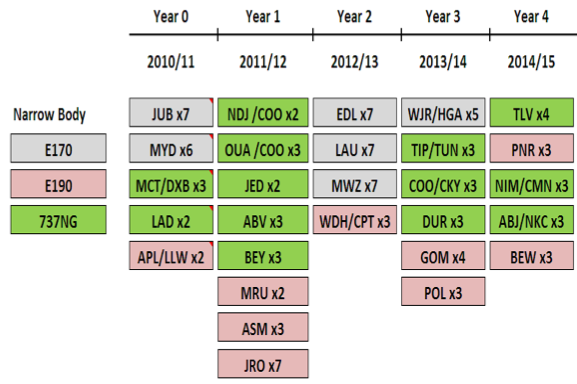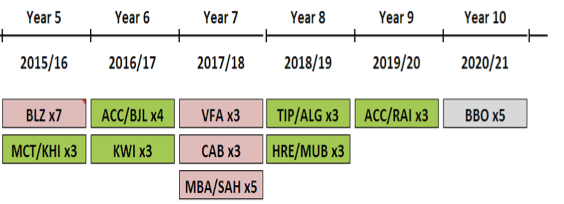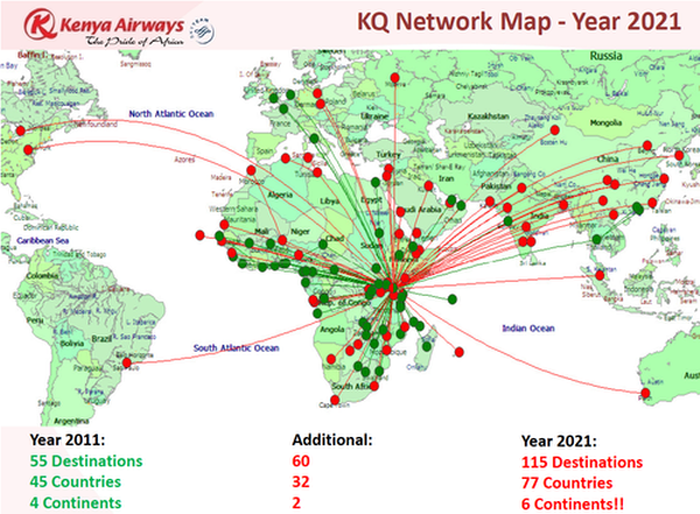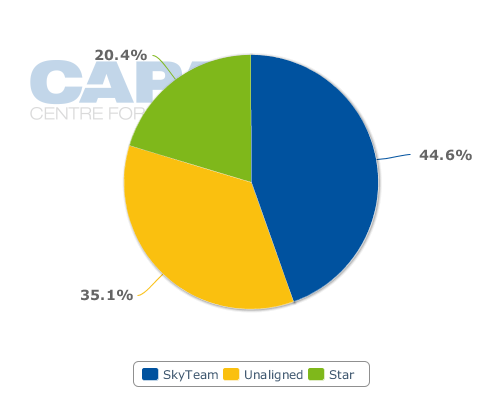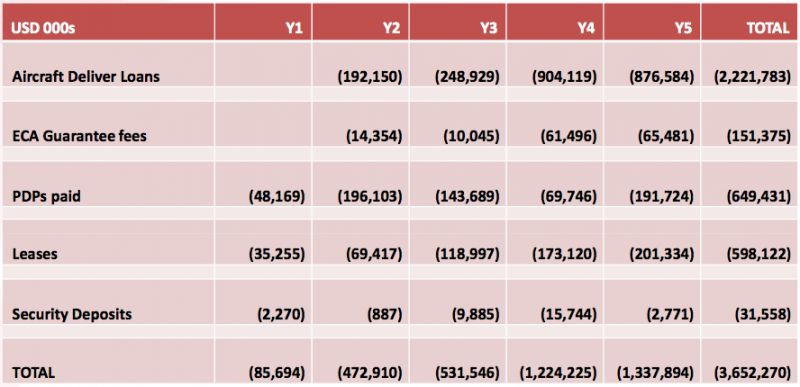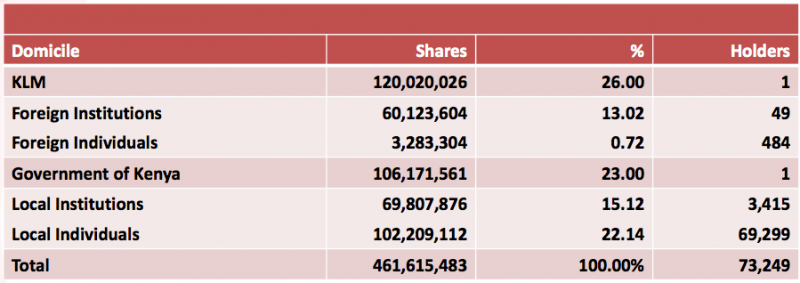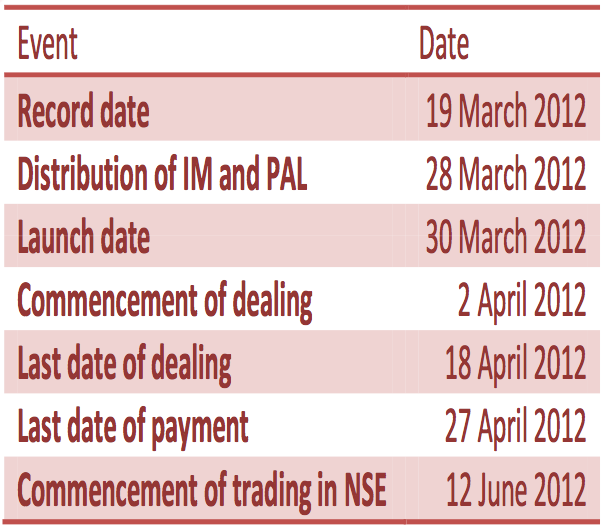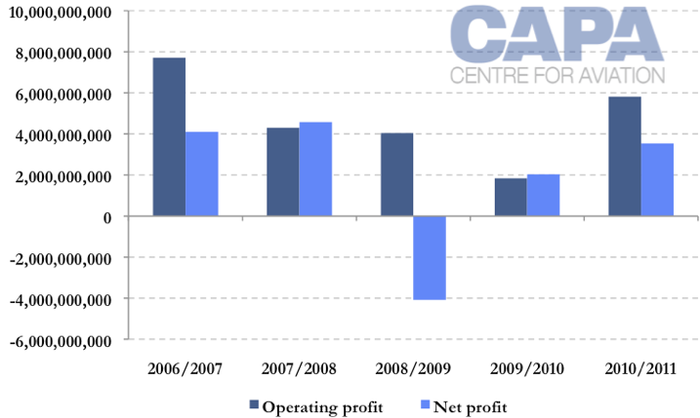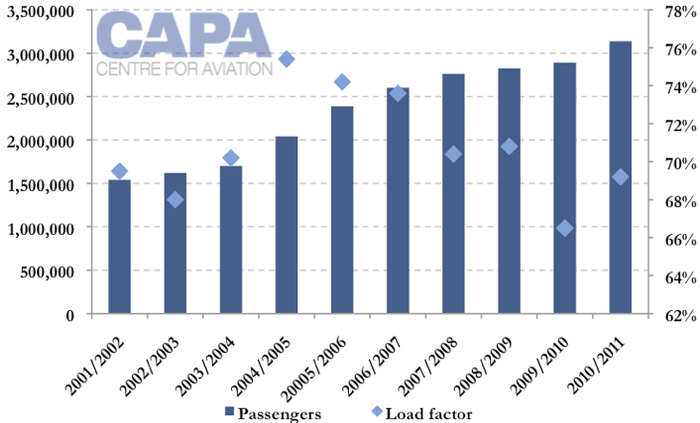Rapidly expanding Kenya Airways charts growth with plan to serve every inhabited continent by 2017
Kenya Airways plans to launch its first services to North America, South America and Australia by 2017, making it one of the few carriers to serve every inhabited continent. While these three continents will give Africa's currently fifth-largest airline by seats a global presence, its future is pegged on Asia, with the carrier over the next 10 years planning to launch seven new routes into China, six in the Indian Subcontinent and three across North and Southeast Asia as well as having a growing presence in Europe and the Middle East. It is poised to become Africa's largest carrier.
Growth will be fuelled by Africa's status as a burgeoning market, as well as reliance on partners: Kenya Airways will open routes to SkyTeam member hubs in Xiamen (Xiamen Airlines), Hanoi (Vietnam Airlines), Seoul (Korean Air), Moscow (Aeroflot) and Prague (Czech Airlines). The intercontinental focus follows Kenya's strong emphasis on regional Africa, with the carrier aiming to serve every African nation by the end of 2013.
With the carrier intending over the next decade to add 60 destinations in 32 countries while more than tripling its fleet to 107 aircraft, almost half widebodies, Kenya Airways will become a formidable force and help to finally bring African aviation into the world's limelight. Its strength along with that of Ethiopian Airlines will shift the continent's focus from South Africa, home of traditional heavyweight South African Airways, to East Africa, giving the two carriers network opportunities but also creating a competitive rivalry - a welcome addition for a continent that for too long has played in the world's shadows.
24 new widebody points to be opened by 2021
Kenya Airways' growth is part of its strategic management plan called Project Mawingu, named after the Swahili word for clouds. And that is where Kenya Airways is aiming for: clouds, not the stars. Growth projections are high, making additional destinations and frequencies, beyond this initial plan, very likely, especially in the latter half of the decade. As ambitious as the plan may seem - in the last 10 years the carrier went from 30 destinations to 55, but in the next decade will increase to 115 - it is not entirely bullish but instead represents the start of African carriers taking a greater place on the world stage as the continent finally starts recording continuous high growth.
Pending significant additional aircraft orders, for the eight years from 2013 Kenya Airways will open three new points outside of Africa every year in addition to its intra-Africa expansion. FY2014/15 is projected to see Kenya Airways' first South American service with a thrice weekly Boeing 787 flight to Sao Paulo, FY2015/16 the first North American service with thrice weekly 777-200LR flight to Toronto and FY2016/17 the first Australia Pacific service with a thrice weekly 787 flight to Australia's Perth.
Kenya Airways widebody expansion plans with initial equipment and weekly frequency: FY2013/14 to FY2020/21
| FY2013/14 | FY2014/15 | FY2015/16 | FY2016/17 | FY2017/18 | FY2018/19 | FY2019/20 | FY2020/21 |
|---|---|---|---|---|---|---|---|
| Delhi, 767-300, 4x | Beijing, 777-200LR, 3x | Toronto, 777-200LR, 3x | Chengdu, 787, 3x | Washington Dulles, 777-200LR, 3x | Xiamen, 787, 3x | Kunming, 787, 3x | Prague, 787, 3x |
| Kuala Lumpur 767-300, 3x | Sao Paulo, 787, 3x | Abu Dhabi, 787, 3x | Perth, 787, 3x | Hyderabad, 787, 3x | Moscow, 787, 3x | Dhaka, 787, 3x | Urumqi, 787, 3x |
| Bangalore, 787, 3x | Berlin, 787, 3x | Shanghai, 787, 3x | Chennai, 787, 3x | Chongqing, 787, 3x | Ahmedabad, 787, 3x | Seoul, 787, 3x | Hanoi, 787, 3x |
But Kenya's expansion in existing continents is far more comprehensive, potentially alluring and also guaranteed with lower risks. Guangzhou is the currently the carrier's sole mainland Chinese destination, but by 2021 Kenya Airways will open seven more: Beijing, Shanghai, Chengdu, Chongqing, Xiamen, Kunming and Urumqi. (Kenya Airways previously flagged greater interest in China but did not name specific points.)
The expansion speaks of the enormous potential of the Chinese market: the focus today is currently on Beijing and Shanghai with only some carriers beginning to explore secondary Chinese cities like Chengdu. Few discuss, publicly at least, even more secondary points like Urumqi. Although Kenya Airways' discussions may be on the foresight, its expansion in China will lag other carriers. Shanghai, a point already served by most major European carriers, will not come online at Kenya Airways until 2015/16. Chengdu, the carrier's first secondary city, will open in 2016/17, by which time European carriers and even Middle East network carriers will likely be examining third- and fourth-tier Chinese cities. The slower pace is reflective of aircraft delivery dates and previous delays as well as the time needed for further Chinese investment in Africa to support the new routes. Its expansion in India will also be significantly behind the Middle East network carriers that quickly planted themselves on the subcontinent.
Narrowbody expansion to open 40 destinations across Africa, Middle East
Kenya Airways expanding narrowbody fleet, also subject to further orders, will facilitate expansion across Africa and the Middle East. A significant proportion of routes will be opened by the Embraer E190, smaller than 737-sized aircraft network carriers have relied on. This will help make previously unviable routes profitable or to help increase frequency.
Kenya Airways narrowbody expansion plans with initial equipment and weekly frequency: FY2010/11 to FY2014/15
Kenya Airways narrowbody expansion plans with initial equipment and weekly frequency: FY2015/16 to FY2020/21
Kenya Airways projected route network: 2021
Kenya Airways will follow Ethiopian Airlines into many new markets
Some elements of Kenya's expansion plan mirror that of regional competitor Ethiopian Airlines, which has been more enterprising in its intercontinental network while focusing less on regional Africa, the opposite of Kenya Airways. Ethiopian will launch services to Toronto later this year and Kenya Airways will enter in 2015/16. In 2017/18 Kenya will join Ethiopian in serving Washington Dulles. Ethiopian told CAPA it is evaluating Kuala Lumpur and Chongqing, two destinations Kenya Airways now intends to launch to.
See related article: Ethiopian eyes 787 service to Hong Kong and new Asian services as Africa-Asia market booms
While there can be understandably similar interests in intercontinental points from Africa, elements of Kenya's plan require further analysis. Ethiopian at Dulles benefits from Star Alliance partner United Airlines and will benefit in Toronto from Star partner Air Canada. Neither destination has a large presence from SkyTeam, the alliance Kenya Airways is part of. Delta Air Lines in fact recently relinquished slots at Washington National in favour of a larger New York City presence. Ethiopian mid-last decade pulled out of New York Newark, where it had few feed opportunities in comparison to Washington, where it had an interline agreement with United (at the time, United and major Newark carrier Continental Airlines had yet to merge and Continental was part of SkyTeam). While Kenya Airways will aim to have a wider network across Africa from which to pull traffic for long-haul routes, current lack of network feed on the other end will be challenging for a number of routes.
Partners will have important role for Asian and European destinations
Strong local traffic feed is more evident in Kenya Airways' Asian and European expansion. Of the three North and Southeast Asian destinations Kenya plans to expand to - Hanoi, Kuala Lumpur and Seoul - two are already SkyTeam hubs: Vietnam Airlines in Hanoi and Korean Air in Seoul. Korean Air has announced intentions to link Seoul with Nairobi, indicating the potential for such hub-to-hub flying.
See related article: Emerging Africa-Asia market continues to grow with Korean Air service to Nairobi from Seoul
Kenya Airways will also benefit in China from SkyTeam's majority position. Based on current capacity and assuming pending members - such as Xiamen Airlines - complete alliance membership, SkyTeam will represent 45% of available domestic seats in China. This will help facilitate feed at Shanghai, where SkyTeam member China Eastern is based, although the strong nature of the market places fewer demands for feed. Feed will be more important later at Chongqing and Urumqi, which SkyTeam member China Southern plans to build up as hubs and at Xiamen, where SkyTeam member elect Xiamen Airlines is based.
China domestic capacity alliance predictor: 16-Apr-2012 to 22-Apr-2012
Alliances will also be important for expansion in Europe. Kenya Airways envisions adding service to Berlin in 2014/15, Moscow in 2018/19 and Prague in 2020/21. Nairobi-London is currently Kenya's largest intercontinental route and this summer will deploy 6440 weekly seats. Nairobi-Amsterdam is the third-largest with 4508 weekly seats, a figure disproportionately high compared to the local sizes of London and Amsterdam. But aiding Kenya Airways in Amsterdam is a close partnership with KLM that supplies feed to Kenya's services. (KLM is also a 26% owner of Kenya Airways.)
While Moscow and Prague services are still some time off, the local networks of SkyTeam members Aeroflot and Czech Airlines will help and be alluring as the African market rises in prominence at the same time of Eastern Europe of Russia, where Aeroflot and Czech Airlines are strong in. Berlin could be initially challenging for Kenya Airways as SkyTeam represents less than 5% of capacity - the market is dominated by oneworld's airberlin and Star's Lufthansa - although there is a notable overseas African population, freight demand is high between Germany and Kenya (much currently enters via Amsterdam) and Nairobi, as well as larger Africa, is a popular tourist spot for vacationing Germans. airberlin recently announced it would move to year round its service to Mombassa, the second largest city in Kenya and a tourism hotspot.
South America is quickly becoming a oneworld fortress, especially with TAM likely to join merger partner LAN in oneworld and IAG, owner of British Airways and Iberia, setting its sight on Portugal's TAP, which has an extensive Brazilian network. Star is less noticeable with only Avianca-TACA (assuming TAM leaves). SkyTeam will only be represented by pending member Aerolineas Argentinas, but it is likely Brazil's Gol, which is forming a closer partnership with SkyTeam's Delta (who in Dec-2011 invested in Gol), could join SkyTeam. It would not be critical for Kenya Airways to have local feed in Brazil since Sao Paulo is large enough and Kenya Airways can cash in on opportunities for Asia-Latin America traffic, of which there are no non-stop flights. Kenya Airways will be in the enviable position of linking major Asian cities with a one-stop service to Sao Paulo, although initial frequencies - less than daily - will be limiting for Asia-Latin America traffic via Africa. Ethiopian is positioning itself for a similar status with its intention, mentioned only in passing, to serve Sao Paulo. If Gol joins SkyTeam and works with Kenya Airways, the latter's position will be extremely strong in a very lucrative emerging market that will not be served non-stop in the near future.
Significant fleet expansion planned with more 787s, 777s, 737s and E190s to be ordered
Kenya Airways' 10-year plan will need significant amounts of new aircraft ordered. Most notably, Kenya Airways envisions operating in 2021 32 787s, which will become the carrier's workhorse except where range limits or demand is high enough to support larger aircraft (such as 777s to London and Amsterdam). Kenya Airways also envisions operating 29 next generation 737s and 31 E190s, the latter critical for reaching thinner African routes others have ignored or served with low frequency.
Of the 32 787s, Kenya projects having 26 787-8s and six -9s. It has nine 787-8s on order and no -9s on order, indicating a larger order or delivery from lessors is necessary. Kenya Airways currently operates nine 737-700/800s but has no additional aircraft on order. By the end of this year, it will operate four E190s with about 10 on order, indicating that as with the 787 and 737, additional orders or delivery from lessors will be necessary. Kenya also plans to have a fleet of four 777-200LRs by FY2018/19. It currently has none with none on order. It expects its first 777-200LR in FY2014/15. Kenya Airways also expects to increase its 777-300ER fleet, currently announced as two, to four frames.
This fleet partially mirrors Ethiopian Airlines with the 777-200LR and -300ER strategy, as well as more medium-sized aircraft (Ethiopian has 12 A350s on order), but positions Kenya Airways to be the largest African carrier pending likely additional fleet developments from Ethiopian Airlines.
Kenya's current passenger fleet composition is split 30%/70% between widebody and narrowbody aircraft but in FY2020/21 will be more even, with a 41%/59% split, reflecting greater long-haul expansion.
Kenya Airways passenger fleet plan: FY2010/11 to FY2020/21
Kenya Airways, also like Ethiopian, is planning a sizeable freighter aircraft fleet. It will increase its 747 freighter fleet from the present one to two in FY2012/13. The 747s as part of a joint network with KLM covering Africa-Europe-China freight. The two 747s will be withdrawn in FY2013/14 as the first planned 777-200LR freighters, not yet ordered, are delivered in FY2014/15. Kenya envisions having seven 777-200LR freighters in FY2020/21, by which point it will also expand its 737-400 fleet to five, giving a dedicated freighter fleet of 12. Kenya Airways earlier this year made remarks about fleet expansion but did not specify models and delivery dates.
Kenya Airways passenger fleet plan: FY2010/11 to FY2020/21
Funding needed to back development
To facilitate its route and fleet development, Kenya Airways estimates it will need approximately USD3.7 billion in financing over the next five years. Much of this will be provided through cash flows and traditional sources of finance such as debt and capital markets.
Kenya Airways aircraft financing requirements: FY2011/12 (Y1) through FY2015/16 (Y5)
The carrier has kicked off its funding plan with a public rights issue, which is now entering its final stages. The carrier plans to issue 1477 million shares at a price of KES14 per share, raising KES20.7 billion (USD250.1 million). The rights issue is touted by Kenya Airways as the largest of its kind in East Africa. The proceeds of the rights issue will form part of the carrier's initial fleet pre-delivery payments for aircraft acquisitions - primarily for 787s and 777s - over FY2013/14 and FY2014/15.
Kenya Airways is a listed company. 30.94% of its shares are controlled by individual shareholders, with local strategic investors holding another 14.2% and foreign investors controlling 5.84%. However, it also has secure backing from KLM, which owns 26% of the airline, and also backing from the Kenyan Government, which has a strategic 23% stake. KLM's part ownership in Kenya Airways was a major part of the carrier's accession into SkyTeam in 2010, a move that has cemented its place as one of Africa's leading carriers.
Kenya Airways shareholder analysis: Dec-2011
Both KLM and the Kenyan Government have agreed to fully take up their rights under the new share issue. However, if the issue is undersubscribed, their uptakes will be scaled back to maintain their respective share ownership levels. Kenya Airways CEO Titus Naikuni is confident the rights issue will be fully subscribed. The CEO stated at the end of Mar-2011 that the airline had already received commitments for 70% of the issue, with local and institutional shareholders willing to take up the shares despite the fact that the carrier's share price has been hovering at, or below, the issue price of KES14 (USD17 cents) for most of Apr-2011.
Kenya Airways rights issue timetable
Building on success
Kenya Airways is one of the most successful and consistently profitable airlines in Africa. The carrier has achieved five straight years of operating profits, as well as net profits over four of the past five years. In FY2010/11 (year ending 31-Mar-2012), the carrier reported a net profit of KES3.5 billion (USD42.6 million), improving significantly on the previous financial year.
Kenya Airways operating and net profits: FY2006/07 to FY2010/11
Over the first half of the 2011/12 financial year, the carrier continued its run of solid profitability, with an operating result of KES1 billion (USD12.8 million) and a net result of KES2 billion (USD24.5 million). The large improvement in the net result was mostly due to a KES1.5 billion (USD17.5 million) gain on fuel derivatives.
Traffic has gone from strength to strength, as the airline has developed its network and grown its fleet. The carrier operates to 56 destinations, 45 of them within Africa. It has progressively been adding to its fleet, most recently adding Embraer regional jets to operate to smaller African destinations as well as domestic routes.
Kenya Airways passenger traffic and average load factor: 2001/02 to 2010/11
The carrier handled a little over 3.1 million passengers in FY2010/11. It expects to handle approximately 3.7 million passengers for the year to 31-Mar-2012, and more than 4 million passengers in 2012/13.
Despite Kenya Airways' strong traffic outlook, African traffic was subdued during most of 2011, partly due to the political instability in the North African region during the year. Kenya Airways continues to face growing competition from European and Middle East network carriers.
African international traffic (RPKs): Feb-2005 to Nov-2011
According to the Africa Airlines Association, African airlines only operated 35% of Africa-Europe capacity in Mar-2012 and 36.8% of Africa-Middle East capacity.
African intra-regional and international capacity data: Mar-2012
|
Seats per week |
Flights per week |
% African carriers |
Seats per week |
Flights per week |
% Other carriers |
|
|---|---|---|---|---|---|---|
|
Intra Africa |
1,367,218 |
13,354 |
98.10% |
26,482 |
139 |
1.90% |
|
180,089 |
1048 |
35.09% |
333,158 |
1,646 |
64.91% |
|
|
9510 |
36 |
56.37% |
7362 |
31 |
43.63% |
|
|
87,384 |
465 |
36.83% |
149,885 |
720 |
63.17% |
|
|
Africa-Asia |
26,017 |
95 |
76.22% |
8115 |
29 |
23.78% |
|
Total |
1,670,218 |
14,998 |
525,002 |
2565 |
Kenya Airways also launching LCC Jambo Jet
Kenya Airways is also showing diligence to the local regional situation, which has seen the entrance of new carriers, including LCC Fly540. Kenya Airways has responded with intentions to establish its own LCC, Jambo Jet. The move is notable given how optimistic airlines elsewhere in the world have been or still are about the threat posed by LCCs, even when such carriers are clearly making significant inroads at the expense of traditional carriers. Responding early, as Kenya Airways intends to do - although details are few - shows prudence not frequently found in the world.
Competition increasing in a growth market, but Kenya Airways not ignoring its potential
Kenya Airways also faces an increasingly competitive intercontinental market. Its main competition is Ethiopian Airlines, also one of Africa's few consistently profitable airlines. The airline is expanding aggressively and possesses a strong network through eastern, southern and Equatorial Africa. Its membership in Star Alliance, which it joined in Dec-2011, also gives it access to an extensive intercontinental network and traffic feed, in addition to the routes it operates with its own metal, giving it benefits Kenya Airways has enjoyed during the past few years it was a member of SkyTeam.
Ethiopian Airlines is already ahead of Kenya Airways in several key markets and has made Asian, and Chinese specifically, expansion a cornerstone. It operates to three mainland Chinese destinations: Beijing and Guangzhou (via Delhi) and Hangzhou (via Bangkok). The carrier will strengthen its Africa-Asia operations from Jun-2012, when its takes delivery of its first 787s. The carrier is interested in more routes in China, as well as Malaysia and Singapore. Airbus projects Africa will be the highest market of proportional growth into Asia Pacific with an 8.4% growth rate, eclipsing the intra-Asia-Pacific rate of 7.5%.
See related article: Ethiopian eyes 787 service to Hong Kong and new Asian services as Africa-Asia market booms
Threatening to pull away international traffic is the strength of the Middle East's sixth freedom network carriers, which are expanding extensively in Africa. Turkish Airlines is also expanding in Africa, reaching not just larger cities but smaller ones too. The steadily expanding scope of their networks puts most major international destinations just one stop away from most African capitals. North American and other European carriers have also expressed increasing interest in African destinations.
See related articles:
- United Airlines eager to tap expected growth in US-Africa market
- Brussels Airlines to further expand in Africa and launch New York but cut back in Europe
African carriers have geography on their side, offering more convenient one-stop connections to Asia, although frequency, connection timing and hub facilities do not always rival the experienced Middle East network carriers. Those network carriers pose a bigger threat to South African Airways. Ethiopian and Kenya Airways will also increasingly threaten SAA, vulnerable as an end-of-line carrier. Although it has had the advantage of a strong southern Africa network, such connections require backtracking through Johannesburg. Kenya Airways' combination of a regional Africa network combined with multiple Asian points - SAA only serves Beijing, Hong Kong and Mumbai in Asia - are a serious threat for SAA.
Kenya Airways already has a solid operational base and has proven it can be sustainably profitable. Despite the recent softness of passenger and traffic growth in Africa, both the regional and long-haul markets are expected to be buoyed by the economic growth and increasing foreign investment in the region. Long-term projections for Africa put overall passenger traffic growth at 5.1-5.7% p/a and the regional aircraft fleet is expected to double over the next 20 years, with Kenya Airways' plans exemplifying that. The time for success has come not only for African carriers, but network carriers like Ethiopian and Kenya Airways, as opposed to limited end of line carriers. Although finer details of Kenya Airways' plan may need revision, it is clear the carrier is not going to miss out on a once in a lifetime expansion opportunity.
